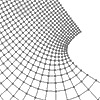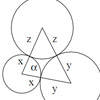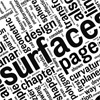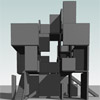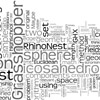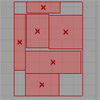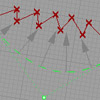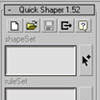In 1982, it has been more than 15 years since the dataflow approach to algorithm designing are discussed in computer science. Computer journal publishes a special issue with the foreword of Tilak Agerwala; he says; …We have discussed two characteristics of the von Neumann model of computation: global updatable memory and a single program counter. It will become clear shortly that the data flow model has neither of these. First, the data flow model […]
Posts categorized under Publications
Studying circle packing led me back to my high school days. First, I’ve tried to write a vb.net component so that I would say Grasshopper to place circles and check lots of things iterating again and again. Then I felt that this was not my real interest in circle packing. After finding an old post by Daniel Piker (here), I’m truly enlightened about an old topic of our high school […]
When I was younger, among the branches of philosophy, I had studied a little logic and, among the subjects of mathematics, geometrical analysis and algebra, three arts or sciences which looked as if they ought to contribute something to my project. But in looking at them, I took care, because, so far as logic is concerned, its syllogisms and most of its other instructions serve to explain to others what […]
Since last week, I’m very curious about circle packing. There are a couple of complete solutions on the internet. I’m still in the early steps of such a solution yet. A full circle packing means that it does not include any gaps and each circle is tangent to all possible neighbors. Sounds easy in Grasshopper but I couldn’t see any solution yet. There are some circle-packing attempts but they have […]
Which keywords are the most popular, regarding contemporary architectural geometry? Above is the wordle.net analysis result for all 155k words of the famous book “Architectural Geometry” by H. Pottmann, A. Asperl, M. Hofer, and A. Kilian. Not many surprises though, this may be a starting point for research on today’s understanding of geometry in architectural design. You can click on the image to see the top 500 words mentioned in […]
Here is the preface of the famous book “Architectural Geometry”. It simply encourages me to learn new things every day even sometimes it seems to become impossible. Geometry lies at the core of the architectural design process. It is omnipresent, from the initial form-finding stages to the actual construction. Modern constructive geometry provides a variety of tools for the efficient design, analysis, and manufacture of complex shapes. This results in […]
Joseph Bergin‘s pedagogical patterns for computer science education returned my attention to teaching methods I’ve searching for almost five years. Here is a phrase from a paper submitted to pedagogical pattern language project: Most educators and trainers are not taught how to teach. Rather, they often find themselves teaching by accident. Typically, a person with a skill that is in demand, such as a particular programming language, will be asked to teach […]
The logical structure of computer-aided architectural design tools is based on object orientation. New design methodologies named Building Information Modeling or Virtual Building aim to improve this structure by synchronizing the digital object classes with real architectural products. Therefore, CAD becomes smart and parametric. But from the design educator’s point of view, most commercial CAD tools are not useful and too complicated to implement basic spatial concepts. This is the […]
Here is an interesting six-year-old quote from Rivka Oxman, telling us about a potential class of designers. The particular character, type, class or whatever we call could be more sophisticated people than we imagine today. It tells me that, advances in design computing does make high-end techniques available for large communities, and re-define basics of architectural geometry for everyone in digital age, but always there seem to remain a small […]
I recently discovered Wordle, a visualization tool for websites. I’m very curious about the social network of design computing community. Trying to understand the trends, how the knowledge is spreading, and the role of different actors on this developing field of architectural design. First of all, I analyzed designcoding.net with all words within 103 posts until today (Click on the image for full size). Wordle can be visited by clicking here. […]
Here are several passages from Shamos’s dissertation thesis, where he is studying the history of geometry from the perspective of a computer scientist. This topic always fascinated me. However, this is a good reading for the algorithmic roots of geometry. “…Egyptian and Greek geometry were masterpieces of applied mathematics. It is well established that the original motivation for tackling geometric problems was the need to tax lands accurately and fairly […]
After the starting point of the Galapagos, there came another attempt to utilize this beautiful addition of David Rutten. This time, I worked over the night to tell it what I want. The aim was (or seemed to be) simple at first sight. I wanted several shapes (not one) to fit into an area, as smallest as possible, without overlaps. This is packing objects. A bounding box and area components quickly […]
…While it is true that every curve which can be described by a continuous motion should ve recognized in geometry, this does not mean that we should use at random the first one that we meet in the construction of a given problem. We should always choose with care the simplest curve that can be used in the solution of a problem, but it should be noted that the simplest […]
Today, there are pedagogical and practical challenges on the use of algorithms in architectural design, as computer puts not only a physical but also a cognitive layer between designer and the subject. Formulation of this cognitive layer is becoming important, regarding which model of computing is used to connect designer with the subject. Is it a “designerly” search, or design exploration in a visual programming environment? As most of the researchers admit […]
Searching for a meaning to today’s popular design methods and concepts we are all going after. Most of the abstract problems, today described within architectural domains, are very parallel to another field defined by M. Ian Shamos in 1978. Here is the introduction paragraph of his PhD thesis; Geometry is a subject that has captured the imagination of Man for at least 2500 years. It is at the very foundation […]
QuickShaper (QS) an experimental computer utility for Shape Grammars. It aims to assist designers and students in creating and exploring rule-based designs. QS is first presented and published with Birgül Çolakoğlu at the 25th eCAADe Conference held at Frankfurt / Germany in September 29th, 2007. QS is a scripted utility, written in MaxScript, developed within Autodesk’s 3D Studio MAX version 9. It is not tested on earlier versions. QS works […]
Whenever we try to define something suitable for our design intentions, it became somehow closely related to the design tool. The contemporary theory of computational design (or design computing) has many definitions. In this website, we look at that from the perspective of method and its theory underneath, not the tools; however, it finally comes to a point that we -again- start to talk about “tools”. Whatever, the purpose is […]
In recent years, computational approaches in architecture started to change the scope of the architect’s work. He/she is not any more a passive tool user instead, became a casual tool developer. Conventional CAD systems that focus on geometric representation of a designed artifact, are transforming into systems in which the design is represented as a parametric process. By increasing utilization of these systems in architectural design process, parametric modeling is integrated not only as a new medium of design representation, […]
Information Age has been transforming architecture, provoking its theoretical and methodological foundations. We might call this as a paradigm shift or not; it’s obvious that contemporary research fields and built practices lead architectural design into a certain revolution. Mainstream schools of design education are becoming more involved in this revolution, with a common purpose; the need to construct a logical connection between contemporary design theories utilizing methods called popularly as […]
Design computing in architecture is evolved enough to form a more spread out advance, instead of being an alternative way of thinking and practising. Contemporary architectural practice is beginning to push forward such a transformation. This also effects architectural education, that is beginning to focus on digital design paradigm especially at undergraduate level not only in experimental studios, but also in formal education. Design studios however, play an important role […]


